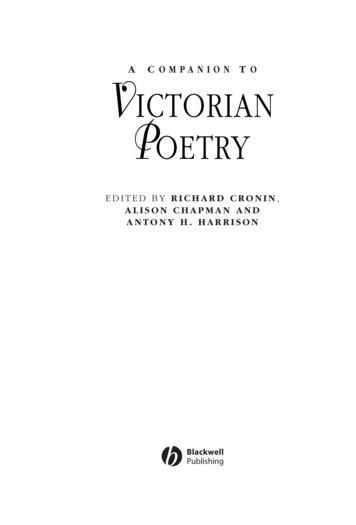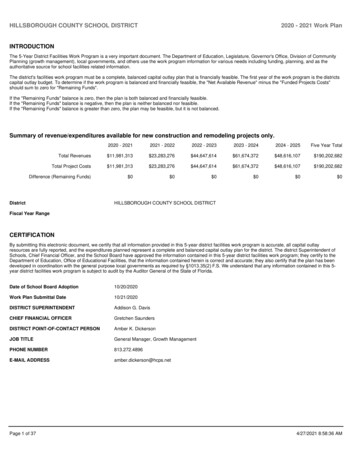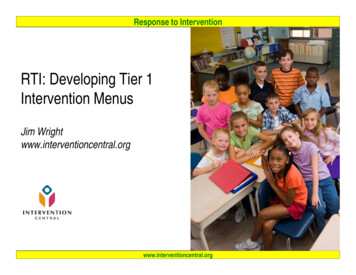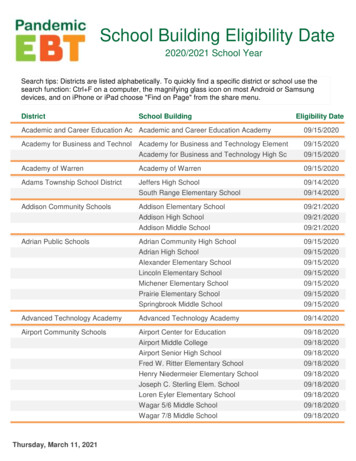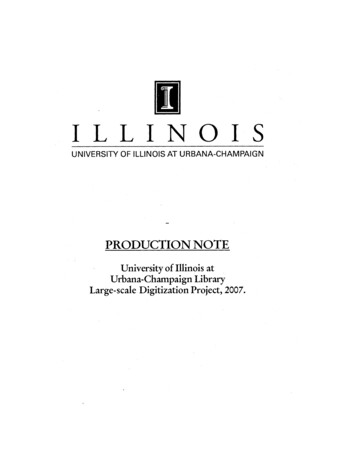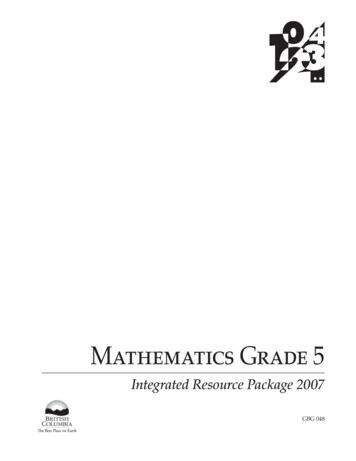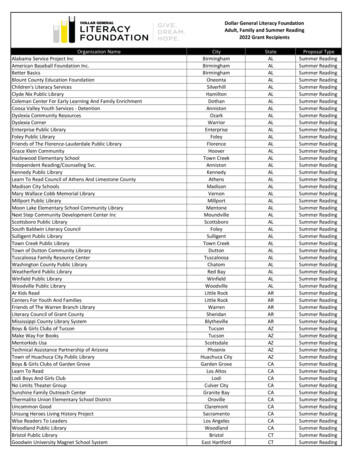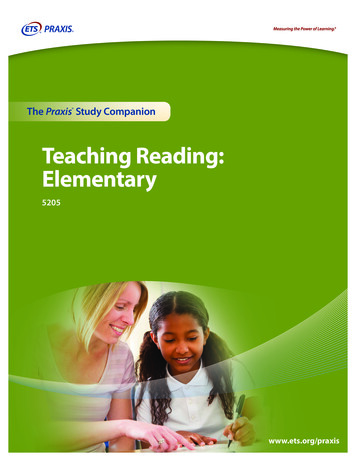
Transcription
The Praxis Study CompanionTeaching Reading:Elementary5205www.ets.org/praxis
Welcome to the Praxis Study CompanionWelcome to the Praxis Study CompanionPrepare to Show What You KnowYou have been working to acquire the knowledge and skills you need for your teaching career. Now you areready to demonstrate your abilities by taking a Praxis test.Using the Praxis Study Companion is a smart way to prepare for the test so you can do your best on test day.This guide can help keep you on track and make the most efficient use of your study time.The Study Companion contains practical information and helpful tools, including: An overview of the Praxis tests Specific information on the Praxis test you are taking A template study plan Study topics Practice questions and explanations of correct answers Test-taking tips and strategies Frequently asked questions Links to more detailed informationSo where should you start? Begin by reviewing this guide in its entirety and note those sections that you needto revisit. Then you can create your own personalized study plan and schedule based on your individual needsand how much time you have before test day.Keep in mind that study habits are individual. There are many different ways to successfully prepare for yourtest. Some people study better on their own, while others prefer a group dynamic. You may have more energyearly in the day, but another test taker may concentrate better in the evening. So use this guide to develop theapproach that works best for you.Your teaching career begins with preparation. Good luck!Know What to ExpectWhich tests should I take?Each state or agency that uses the Praxis tests sets its own requirements for which test or tests you must take forthe teaching area you wish to pursue.Before you register for a test, confirm your state or agency’s testing requirements at www.ets.org/praxis/states.How are the Praxis tests given?Praxis tests are given on computer. Other formats are available for test takers approved for accommodations (seepage 39).The Praxis Study Companion2
Welcome to the Praxis Study CompanionWhat should I expect when taking the test on computer?When taking the test on computer, you can expect to be asked to provide proper identification at the testcenter. Once admitted, you will be given the opportunity to learn how the computer interface works (how toanswer questions, how to skip questions, how to go back to questions you skipped, etc.) before the testing timebegins. Watch the What to Expect on Test Day video to see what the experience is like.Where and when are the Praxis tests offered?You can select the test center that is most convenient for you. The Praxis tests are administered through aninternational network of test centers, which includes Prometric Testing Centers, some universities, and otherlocations throughout the world.Testing schedules may differ, so see the Praxis web site for more detailed test registration information at www.ets.org/praxis/register.The Praxis Study Companion3
Table of ContentsTable of ContentsThe Praxis Study Companion guides you through the steps to success1. Learn About Your Test.5Learn about the specific test you will be taking2. F amiliarize Yourself with Test Questions.9Become comfortable with the types of questions you’ll find on the Praxis tests3. Practice with Sample Test Questions. 13Answer practice questions and find explanations for correct answers4. Determine Your Strategy for Success. 26Set clear goals and deadlines so your test preparation is focused and efficient5. Develop Your Study Plan. 29Develop a personalized study plan and schedule6. Review Study Topics. 33Detailed study topics with questions for discussion7. Review Smart Tips for Success. 37Follow test-taking tips developed by experts8. Check on Testing Accommodations. 39See if you qualify for accommodations to take the Praxis test9. Do Your Best on Test Day. 40Get ready for test day so you will be calm and confident10. Understand Your Scores. 42Understand how tests are scored and how to interpret your test scoresAppendix: Other Questions You May Have . 44The Praxis Study Companion4
Step 1: Learn About Your Test1. Learn About Your TestLearn about the specific test you will be takingTeaching Reading: Elementary (5205)Test at a GlanceTest NameTeaching Reading: ElementaryTest Code5205Time150 minutesNumber of Questions90 selected response; 3 constructed responseFormatSelected-response and constructed-response questions. This test may includequestions with an audio or video component.Test DeliveryComputer deliveredContent CategoriesApproximateNumber ofQuestionsApproximatePercentage ofExaminationII. Phonological and Phonemic1311%Awareness including EmergentLiteracyVIIIIIIVIVII.Phonics and DecodingIII. Vocabulary and Fluency1815%2118%IV. Comprehension of Literary and2218%Informational TextV.Writing15VI. Assessment and Instructional3Decision Making (ConstructedResponse)13%25%About This TestThe Praxis Teaching Reading: Elementary test focuses on the knowledge and skills a beginning teacher musthave to support reading and writing development in kindergarten through sixth-grade students. Built toassess the science of reading, the test is structured around the five essential components of effective readinginstruction as identified by the National Reading Panel: phonemic awareness, phonics, vocabulary, fluency, andcomprehension. The test also assesses the relationship between reading skills and writing instruction, sincereceptive and productive literacy are interrelated. Questions about assessment will be included throughout.The test as a whole acknowledges multiple approaches to pedagogy used in tandem with content. Thisincludes but is not limited to integrating skills and embedding student instruction within context, as well aslooking at concepts in isolation in order to build upon them.Test questions call on the individual’s knowledge of research-based reading instruction and the science ofteaching reading, covering language, foundational skills and comprehension. Test takers must be able to applythat knowledge to specific instructional scenarios, including showing an understanding of how to differentiateinstruction for diverse students. The test taker will be required to analyze and respond to situations involvingThe Praxis Study Companion5
Step 1: Learn About Your Testboth entire classes and individual students at gradelevels from kindergarten through grade six, includingEnglish-language learners and students with diverseneeds and backgrounds.E.Understands instructional strategies to helpemergent readers fluently identify upper- andlowercase letters in various fontsII. Phonics and DecodingThe test includes texts from a wide range of genresand requires the candidate to be familiar withstrategies for handling multiple text types withstudents, including print, digital, and image-basedprompts.A.Understands how to teach phoneme-graphemecorrespondenceB.Understands methods for teaching phonicssystematically, explicitly, and recursivelyIn addition to selected-response questions,the test contains three constructed-responsequestions designed to allow the test taker toshow understanding in the areas of early literacy,developing reading instruction, and writtenexpression. These questions are intended to beauthentic teaching tasks that require instructionaldecision making about such things as choosinginstructional strategies and materials based onassessment information.C.Knows instructional methods for teachingcommon phonics patterns and rules (consonantdigraphs, blends, diphthongs, schwa sound,syllable types, word families, etc.)D.Knows how to teach morphological analysis (i.e.,affixes, roots, and base words)E.Knows how to teach syllable types in decodingmultisyllabic wordsF.Is familiar with multisensory approaches forsupporting student recognition of nondecodable/irregularly spelled words (i.e., was, listen, though,the, once)This test may contain some questions that will notcount toward your score.Test SpecificationsTest specifications in this chapter describe theknowledge and skills measured by the test. Studytopics to help you prepare to answer test questionscan be found on page 33.I. Phonological and Phonemic Awarenessincluding Emergent LiteracyA.B.C.D.Understands instructional methods forteaching phonological awareness (recognition ofrhyme and alliteration; segmenting, blending,manipulation of syllables as well as onset andrime)Understands instructional methods for teachingphonemic awareness, both basic (e.g., segmentingand blending) and advanced (e.g., deletion,substitution)Knows ways to develop students’ expressive andreceptive language skillsKnows instructional methods to teach beginningreaders the concepts about print such asdirectionality, return sweep, parts of a book, andthe form and function of printThe Praxis Study CompanionIII.Vocabulary and FluencyA.Understands ways to build, expand, and useexpressive and receptive vocabularyB.Understands methods for teaching vocabularysystematically, explicitly, and repeatedly inmultiple contextsC.Knows how to match an instructional method toword complexityD.Knows multiple approaches to teaching wordsolving, including the use of context clues andstructural analysisE.Knows how to guide students to understand awide variety of words (common, contextual,content-specific) through direct instruction andindependent vocabulary learningF.Understands instructional methods to fosterstudents’ automaticity through accuracy,appropriate rate, and prosodyG.Knows methods of supporting fluent readingbehaviors at the phoneme, word, and passagelevelH.Knows how fluency, vocabulary, andcomprehension are interrelated6
Step 1: Learn About Your TestIV. Comprehension of Literary andInformational TextV.WritingA.Written ExpressionA.Understands how to support students’ listeningcomprehension and its relationship to readingcomprehension1. Understands how to teach writing as a recursiveprocess that supports self-evaluation andexpressionB.Knows how to support students’ speaking andlistening skills as they discuss texts2. Knows systematic, explicit methods to teach thesteps of the writing process to all learnersC.Understands how to activate and build allstudents’ background knowledge to increasecomprehensionD.E.F.G.3. Knows strategies for integrating reading andwriting (i.e., summarizing, annotation)4. Knows methods to use digital tools forcommunication, writing, collaboration, andpublishingIs familiar with methods for teachingcomprehension systematically and explicitly to alllearners5. Is familiar with the defining characteristics andappropriate instructional methods for teachingthe various types of writing: informational/expository, argument/persuasive/opinion, andnarrativeKnows how metacognition guides students’development of monitoring their owncomprehension and analysis of different types oftextB.1. Knows methods to connect the teaching of bothdecoding and encoding as reciprocal skillsIs familiar with strategies to guide students’ selfselection of appropriate texts to increasemotivation and engagement2. Knows how to take a systematic, explicit,multisensory, and recursive approach to spellingdevelopmentKnows how to differentiate instruction, tasks, andmaterials (print and digital) that are appropriateand culturally responsive to all learnersH.Understands how to teach the use of graphic andsemantic organizers to support comprehensionI.Knows how to teach the genres (i.e., poetry, prose,drama), structures (i.e., story elements), andfeatures of literary textsJ.Knows how to teach literary devices (i.e., figurativelanguage, nuance of words, and alliteration)K.Understands strategies for supporting readers asthey construct literal and inferential meaning,including author’s use of languageL.Understands how to teach the types (i.e.,biography, how-to), structures (i.e., description,cause and effect, sequence), and features ofinformational textsM.Knows how to use technology to supportstudents’ ability to critically examine onlineresources and foster digital literacy, to personalizelearning experiences for students of differentneeds, and to support active learning acrosscontent areasThe Praxis Study CompanionSpelling and Grammar3. Understands methods for teaching the structureof written language, including the rules ofgrammar and mechanicsVI. Assessment and Instructional DecisionMaking (Constructed-Response Items)A.Developing emergent literacy learners(phonological and phonemic awareness, phonics,and decoding/encoding)B.Supporting independent literacy learners (fluency,vocabulary, comprehension, writing)C.Responding to diverse learners (i.e., gifted, Englishlearners, struggling readers and writers, andstudents with learning disabilities)7
Step 1: Learn About Your TestIncluded in ALL Categories:Assessment—statement tying the purpose ofassessment to driving instructionA.Understands how to use data to guide bothindividual instruction and create flexible groupsB.Knows how to apply informal and formal methods(i.e., formative and summative) for assessing allessential elements of beginning literacyinstruction: phonemic awareness, phonics,fluency, vocabulary, comprehension, and writingC.Knows how to monitor student progress byanalyzing and interpreting formative assessmentdata to inform instructionD.Is familiar with the decision-making process thatleads to the modification or accommodation ofassessments based on the needs of diverselearners (i.e., gifted, English learners, strugglingreaders and writers, and students with learningdisabilities)E.Is familiar with ways to integrate digital tools intothe assessment processThe Praxis Study Companion8
Step 2: Familiarize Yourself with Test Questions2. Familiarize Yourself with Test QuestionsBecome comfortable with the types of questions you’ll find on the Praxis testsThe Praxis assessments include a variety of question types: constructed response (for which you write aresponse of your own); selected response, for which you select one or more answers from a list of choices ormake another kind of selection (e.g., by clicking on a sentence in a text or by clicking on part of a graphic); andnumeric entry, for which you enter a numeric value in an answer field. You may be familiar with these questionformats from taking other standardized tests. If not, familiarize yourself with them so you don’t spend timeduring the test figuring out how to answer them.Understanding Computer-Delivered QuestionsQuestions on computer-delivered tests are interactive in the sense that you answer by selecting an optionor entering text on the screen. If you see a format you are not familiar with, read the directions carefully. Thedirections always give clear instructions on how you are expected to respond.For most questions, you respond by clicking an oval to select a single answer from a list of answer choices.However, interactive question types may also ask you to respond by: Clicking more than one oval to select answers from a list of choices. Typing in an entry box. When the answer is a number, you may be asked to enter a numerical answer.Some questions may have more than one place to enter a response. Clicking check boxes. You may be asked to click check boxes instead of an oval when more than onechoice within a set of answers can be selected. Clicking parts of a graphic. In some questions, you will select your answers by clicking on a location (orlocations) on a graphic such as a map or chart, as opposed to choosing your answer from a list. Clicking on sentences. In questions with reading passages, you may be asked to choose your answers byclicking on a sentence (or sentences) within the reading passage. Dragging and dropping answer choices into targets on the screen. You may be asked to select answersfrom a list of choices and drag your answers to the appropriate location in a table, paragraph of text orgraphic. Selecting answer choices from a drop-down menu. You may be asked to choose answers by selectingchoices from a drop-down menu (e.g., to complete a sentence).Remember that with every question you will get clear instructions.Perhaps the best way to understand computer-delivered questions is to view the Computer-delivered TestingDemonstration on the Praxis web site to learn how a computer-delivered test works and see examples ofsome types of questions you may encounter.The Praxis Study Companion9
Step 2: Familiarize Yourself with Test QuestionsUnderstanding Selected-Response QuestionsMany selected-response questions begin with the phrase “which of the following.” Take a look at this example:Which of the following is a flavor made from beans?(A) Strawberry(B) Cherry(C) Vanilla(D) MintHow would you answer this question?All of the answer choices are flavors. Your job is to decide which of the flavors is the one made from beans.Try following these steps to select the correct answer.1) L imit your answer to the choices given. You may know that chocolate and coffee are also flavors madefrom beans, but they are not listed. Rather than thinking of other possible answers, focus only on the choicesgiven (“which of the following”).2) E liminate incorrect answers. You may know that strawberry and cherry flavors are made from fruit andthat mint flavor is made from a plant. That leaves vanilla as the only possible answer.3) V erify your answer. You can substitute “vanilla” for the phrase “which of the following” and turn thequestion into this statement: “Vanilla is a flavor made from beans.” This will help you be sure that your answeris correct. If you’re still uncertain, try substituting the other choices to see if they make sense. You may wantto use this technique as you answer selected-response questions on the practice tests.Try a more challenging exampleThe vanilla bean question is pretty straightforward, but you’ll find that more challenging questions have asimilar structure. For example:Entries in outlines are generally arranged accordingto which of the following relationships of ideas?(A) Literal and inferential(B) Concrete and abstract(C) Linear and recursive(D) Main and subordinateYou’ll notice that this example also contains the phrase “which of the following.” This phrase helps youdetermine that your answer will be a “relationship of ideas” from the choices provided. You are supposed to findthe choice that describes how entries, or ideas, in outlines are related.Sometimes it helps to put the question in your own words. Here, you could paraphrase the question in this way:“How are outlines usually organized?” Since the ideas in outlines usually appear as main ideas and subordinateideas, the answer is (D).The Praxis Study Companion10
Step 2: Familiarize Yourself with Test QuestionsQUICK TIP: Don’t be intimidated by words you may not understand. It might be easy to be thrown by wordslike “recursive” or “inferential.” Read carefully to understand the question and look for an answer that fits. Anoutline is something you are probably familiar with and expect to teach to your students. So slow down, anduse what you know.Watch out for selected-response questions containing “NOT,” “LEAST,” and “EXCEPT”This type of question asks you to select the choice that does not fit. You must be very careful because it is easyto forget that you are selecting the negative. This question type is used in situations in which there are severalgood solutions or ways to approach something, but also a clearly wrong way.How to approach questions about graphs, tables, or reading passagesWhen answering questions about graphs, tables, or reading passages, provide only the information that thequestions ask for. In the case of a map or graph, you might want to read the questions first, and then look at themap or graph. In the case of a long reading passage, you might want to go ahead and read the passage first,noting places you think are important, and then answer the questions. Again, the important thing is to be sureyou answer the questions as they refer to the material presented. So read the questions carefully.How to approach unfamiliar formatsNew question formats are developed from time to time to find new ways of assessing knowledge. Tests mayinclude audio and video components, such as a movie clip or animation, instead of a map or reading passage.Other tests may allow you to zoom in on details in a graphic or picture.Tests may also include interactive questions. These questions take advantage of technology to assessknowledge and skills in ways that standard selected-response questions cannot. If you see a format you arenot familiar with, read the directions carefully. The directions always give clear instructions on how you areexpected to respond.QUICK TIP: Don’t make the questions more difficult than they are. Don’t read for hidden meanings or tricks.There are no trick questions on Praxis tests. They are intended to be serious, straightforward tests ofyour knowledge.Understanding Constructed-Response QuestionsConstructed-response questions require you to demonstrate your knowledge in a subject area by creatingyour own response to particular topics. Essays and short-answer questions are types of constructed-responsequestions.For example, an essay question might present you with a topic and ask you to discuss the extent to which youagree or disagree with the opinion stated. You must support your position with specific reasons and examplesfrom your own experience, observations, or reading.Take a look at a few sample essay topics: “ Celebrities have a tremendous influence on the young, and for that reason, they have a responsibility toact as role models.” “ We are constantly bombarded by advertisements—on television and radio, in newspapers andmagazines, on highway signs, and the sides of buses. They have become too pervasive. It’s time to putlimits on advertising.” “ Advances in computer technology have made the classroom unnecessary, since students and teachersare able to communicate with one another from computer terminals at home or at work.”The Praxis Study Companion11
Step 2: Familiarize Yourself with Test QuestionsKeep these things in mind when you respond to a constructed-response question1) A nswer the question accurately. Analyze what each part of the question is asking you to do. If thequestion asks you to describe or discuss, you should provide more than just a list.2) A nswer the question completely. If a question asks you to do three distinct things in your response,you should cover all three things for the best score. Otherwise, no matter how well you write, you willnot be awarded full credit.3) A nswer the question that is asked. Do not change the question or challenge the basis of thequestion. You will receive no credit or a low score if you answer another question or if you state, forexample, that there is no possible answer.4) G ive a thorough and detailed response. You must demonstrate that you have a thoroughunderstanding of the subject matter. However, your response should be straightforward and not filledwith unnecessary information.5) R eread your response. Check that you have written what you thought you wrote. Be sure not toleave sentences unfinished or omit clarifying information.QUICK TIP: You may find that it helps to take notes on scratch paper so that you don’t miss any details. Thenyou’ll be sure to have all the information you need to answer the question.For tests that have constructed-response questions, more detailed information can be found on page 23.The Praxis Study Companion12
Step 3: Practice with Sample Test Questions3. Practice with Sample Test QuestionsAnswer practice questions and find explanations for correct answersComputer DeliveryThis test is available via computer delivery. The following sample question provides a preview of an actualscreen used in a computer-delivered test. For the purposes of this Study Companion, the sample questions areshown as they would appear in a paper-delivered test.The Praxis Study Companion13
Step 3: Practice with Sample Test QuestionsSample Test QuestionsThe sample questions that follow illustrate the kinds of questionson the test. They are not, however, representative of the entirescope of the test in either content or difficulty. Answers withexplanations follow the questions.Directions: Each of the questions or statements below isfollowed by suggested answers or completions. Select theone that is best in each case.1. A sixth-grade teacher selects several domainspecific vocabulary words from a textbookbefore starting a new chapter. In planning aninstructional strategy, the teacher chooses thenew vocabulary words because they areessential to understanding the new topic. Aninstructional technique that requires studentsto gain the deepest level of vocabularyknowledge is the most appropriateinstructional technique for the teacher toselect.Based on the teacher’s goal, which of thefollowing research-based techniques is bestfor the teacher to include in the instructionalplan?(A) Having students create originalsentences using the words and applyword meanings across contexts(B) Creating activities in which studentscategorize words and generate multiplemeanings for each word(C) Presenting new vocabulary in anauthentic context by asking students touse the words to complete framedsentences(D) Telling students to associate an unfamiliarword with a definition and a synonym oran antonym2. A third-grade teacher has completed arunning record and a spelling inventory foreach member of the class. One studentmisread the words “big,” “chat,” and “pen”during the running record. On the spellinginventory, the student was able tosuccessfully complete all beginning andending consonants in C V C pattern words.Which of the following is the best instructionalfocus for the student?(A) Digraphs(B) Short vowels(C) Word-attack skills(D) Long vowels3. A second-grade teacher is reading the textClick, Clack, Moo: Cows That Type by DoreenCronin to the class. The teacher reads thesentence, “The cows were growing impatientwith the farmer.” The teacher stops readingafter this sentence and says to the class,“Hmm I wonder what the word ‘impatient’means? I know that the farmer just gotanother note from the cows that said theywon’t give any milk. I bet that makes thefarmer really mad! I’m going to keep readingto see whether I can figure out what impatientmeans.” The teacher is using which of thefollowing?(A) A miscue analysis(B) A semantic-feature analysis(C) A think-aloud strategy(D) A running record4. Place the reading strategies in the list in orderaccording to when the strategy is used:before, during, or after reading. Click and drageach strategy to the appropriately labeledbox.SummarizingSelf-monitoringSetting a purpose1. Before reading2. During reading3. After readingThe Praxis Study Companion14
Step 3: Practice with Sample Test Questions5. Which of the following is the best way for ateacher to assess students’ phonologicalawareness?(A) Saying the word “lamp” and askingstudents to come up with rhyming words(B) Asking students to identify the letter atthe beginning of the word “desk”6. Which of the following best identifies the longrange goal of the instructional technique usedto support students’ learning?(A) Providing direct instruction to helpstudents learn the conventions of formalacademic writing(C) Distributing the letter cards “b,” “a,” and“t” and asking students to order theletters to create a word(B) Supporting students’ ability toparaphrase a variety of facts that can belater used as a source in other writingassignments(D) Displaying the written word “cat” andasking students to sound it out as theytap each letter(C) Fostering students’ critical-thinking skillsand processing of key concepts andideas in a content areaA sixth-grade teacher engages students in anactivity that integrates reading and writing in asocial studies unit of study. In the note-takingformat shown, students take notes on the rightside of the organizer as they read part of achapter in the textbook. When the reading iscomplete, the students summarize the main ideasand read the notes they have recorded to developquestions that the notes would answer.Questions Answered bythe NotesNotes(D) Showing students that writing can beused to initiate oral discussions andgenerate a diversity of views about anauthor’s purpose7. Which of the following text-dependentquestions best focuses students to thinkabout the craft and structure of a text?(A) What did the main character do when hesaw the letter? Why?(B) Have you ever read another story likethis? How are they similar?(C) How has Ma and Karin’s relationshipchanged over the course of the story?What changed it?(D) How did the author describe Bradley’suncle? Why did the author choose todescribe him that way?8. A dialogue between a teacher and a studentfollows.Summary of NotesTeacher: What is a nocturnal animal?Student: An animal that stays awake at night.Which of the following probin
Teaching Reading: Elementary (5205) Test at a Glance Test Name Teaching Reading: Elementary Test Code 5205 Time 150 minutes Number of Questions 90 selected response; 3 constructed response Format Selected-response and constructed-response questions. This test may include questions with an audio or video component. Test Delivery Computer delivered

